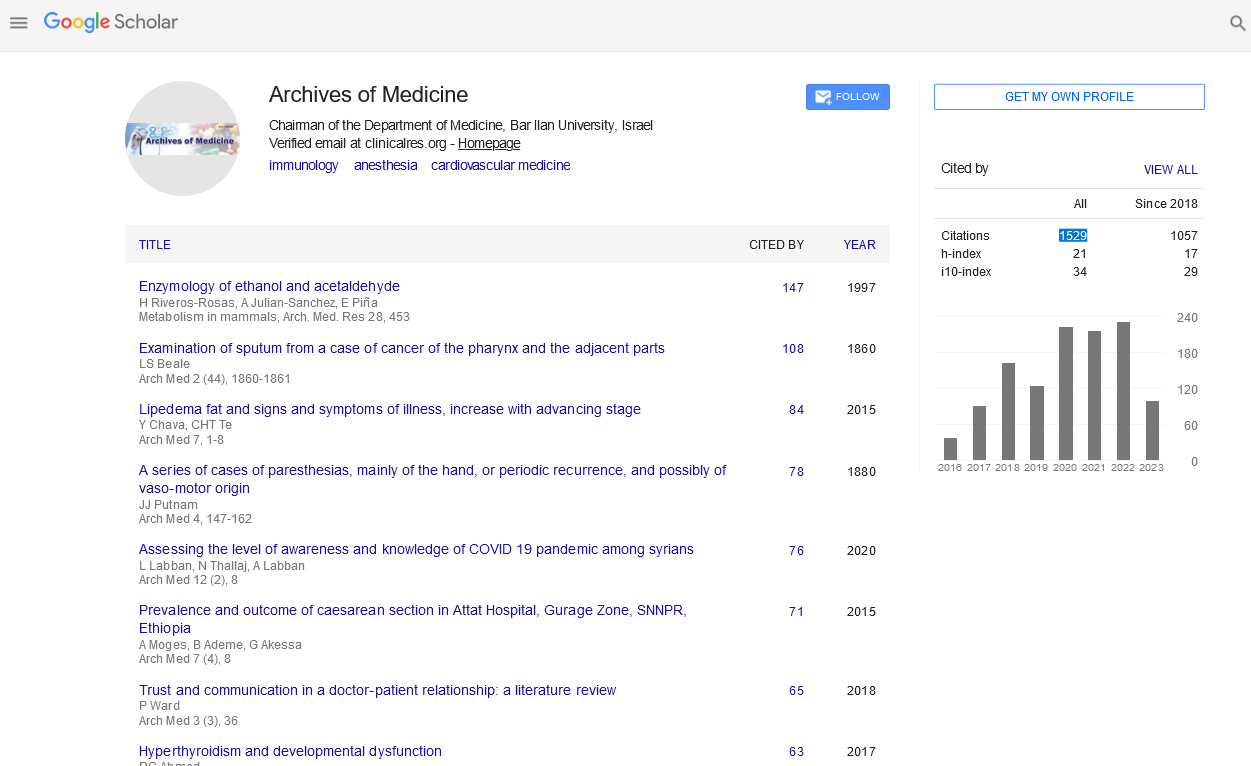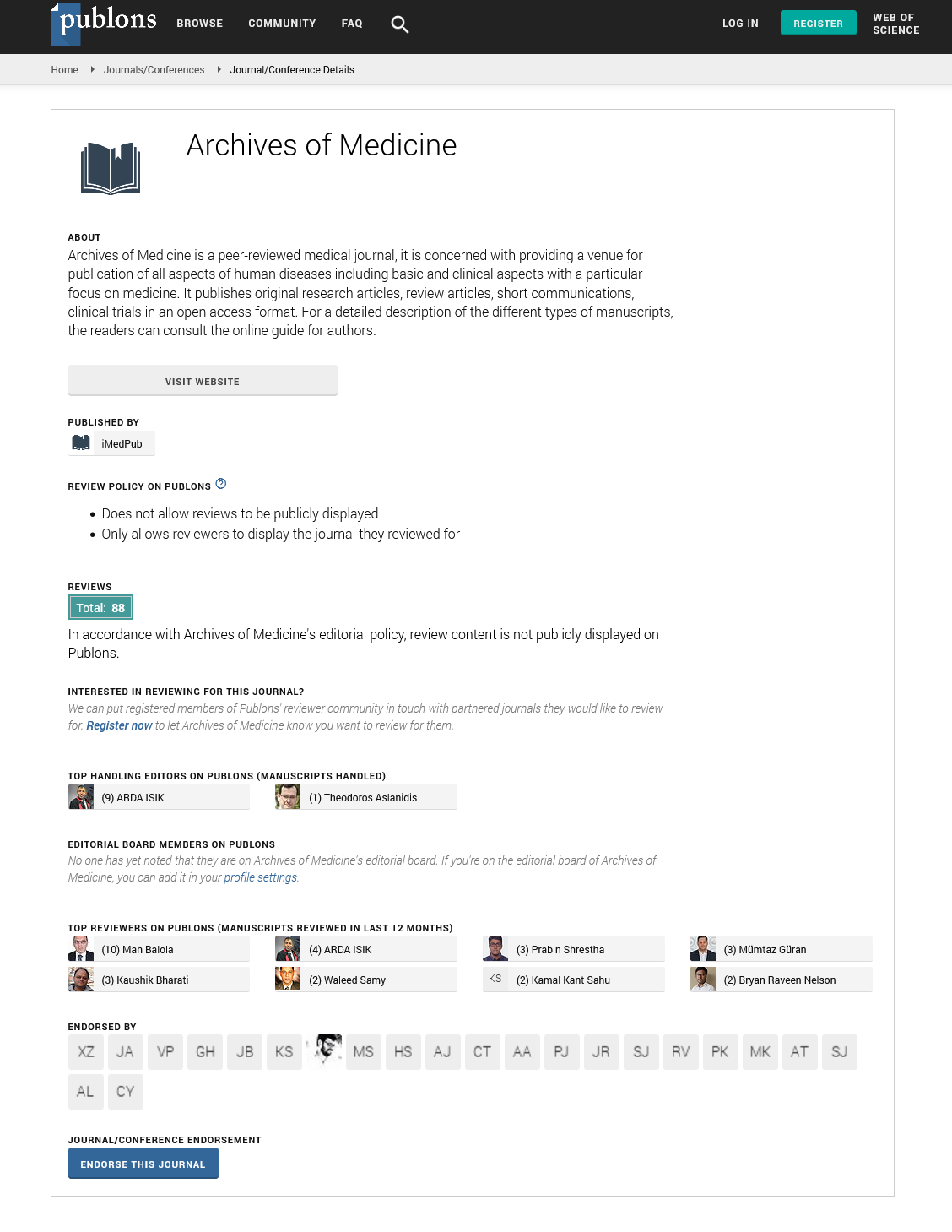Review Article - (2024) Volume 16, Issue 3
From diagnosis to treatment: Internal medicine in focus
Charlotte Blake*
Department of Internal Medicine, University of Western Australia, Crawly, WA, Australia
*Correspondence:
Charlotte Blake, Department of Internal Medicine, University of Western Australia, Crawly, WA,
Australia,
Email:
Received: 01-May-2024, Manuscript No. ipaom-24-14993;
Editor assigned: 03-May-2024, Pre QC No. P-14993;
Reviewed: 15-May-2024, QC No. Q-14993;
Revised: 22-May-2024, Manuscript No. R-14993;
Published:
29-May-2024
Abstract
Internal medicine is a specialized field of medicine focused on the
diagnosis, treatment, and prevention of diseases in adults. Physicians
who specialize in internal medicine, known as internists or internal
medicine doctors, are trained to manage a wide range of medical
conditions affecting various organ systems in the body. They provide
comprehensive, long-term care to patients, serving as primary care
physicians or specialists in hospitals, clinics, and other healthcare
settings. Internal medicine encompasses a broad spectrum of medical
conditions, including chronic diseases such as diabetes, hypertension,
and heart disease, as well as acute illnesses such as infections,
respiratory problems, and gastrointestinal disorders. Internists are
skilled in conducting thorough medical evaluations, ordering diagnostic
tests, interpreting results, and developing personalized treatment
plans tailored to each patient's needs. In addition to diagnosing and
treating medical conditions, internists emphasize preventive care
and health maintenance, with a focus on promoting healthy lifestyle
habits, disease screening, and vaccination. They work collaboratively
with other healthcare professionals, including specialists, nurses,
and allied health professionals, to coordinate care and ensure
comprehensive management of patients' health needs. Internal
medicine encompasses several subspecialties, including cardiology,
gastroenterology, pulmonology, nephrology, endocrinology, infectious
diseases, rheumatology, and haematology/oncology, among others.
Internists may choose to pursue additional training and certification in
one or more subspecialties to provide specialized care for patients with
complex medical conditions.
Keywords
Primary care; Chronic diseases; Infectious diseases;
Subspecialties
Introduction
Internal medicine stands as the bedrock of medical practice, encompassing a vast array of diseases, conditions, and syndromes that affect the internal organs of the human body. It is a field where the intricate interplay of symptoms, signs, and diagnostic tests guides clinicians through the challenging terrain of diagnosis and treatment. From the initial encounter with a patient to the formulation of a comprehensive treatment plan, internal medicine demands not only clinical acumen but also empathy, critical thinking, and a deep understanding of human physiology and pathology. The journey from diagnosis to treatment in internal medicine is multifaceted, often characterized by uncertainty, complexity, and the need for continuous learning and adaptation. This narrative explores the various stages of this journey, shedding light on the processes, challenges, and triumphs encountered along the way.
Overall, internal medicine plays a vital role in the healthcare system by providing comprehensive, patient-centred care to adults across a wide range of medical conditions, from routine check-ups to complex medical management. Internists are dedicated to promoting health, preventing disease, and improving the quality of life for their patients through evidence-based practice and compassionate care [1].
Literature Review
At the heart of internal medicine lies the art of diagnosis; the skillful integration of patient history, physical examination, and diagnostic tests to unravel the underlying cause of a patient's symptoms. The diagnostic process begins with the patient's narrative, as they recount their medical history, symptoms, and concerns. This narrative provides the initial framework upon which the clinician begins to build their differential diagnosis; the list of possible conditions that could explain the patient's presentation. The physical examination serves as a crucial complement to the patient's history, allowing the clinician to gather additional clues and insights. Through careful observation, palpation, percussion, and auscultation, the clinician examines the various organ systems, searching for abnormalities that may further narrow down the differential diagnosis [2].
Diagnostic tests play a pivotal role in confirming or refuting tentative diagnoses. From basic laboratory investigations, such as complete blood counts and basic metabolic panels, to advanced imaging modalities, such as computed tomography and magnetic resonance imaging, these tests provide objective data to support clinical hypotheses. Yet, the diagnostic process is not always straightforward. Uncertainty and ambiguity are inherent to medicine, and clinicians must navigate this uncertainty with humility and diligence. Rare diseases, atypical presentations, and confounding factors can complicate the diagnostic journey, requiring clinicians to exercise patience, creativity, and persistence. Once a diagnosis has been established, the focus shifts to treatment; a dynamic process informed by evidence-based medicine, clinical guidelines, and the unique characteristics of each patient. Treatment may encompass pharmacotherapy, lifestyle modifications, surgical interventions, or a combination thereof, tailored to address the underlying pathology and improve the patient's outcomes [3].
Pharmacotherapy, often the cornerstone of treatment in internal medicine, relies on the judicious use of medications to alleviate symptoms, modify disease progression, and prevent complications. From antibiotics and analgesics to antihypertensive and anticoagulants, the pharmacopeia of internal medicine encompasses a vast array of drugs targeting diverse physiological pathways. Lifestyle modifications play a complementary role in the management of many medical conditions, particularly those influenced by modifiable risk factors such as diet, exercise, and smoking. Education, counselling, and support empower patients to take an active role in their own health, fostering long-term adherence to healthy behaviours. In some cases, surgical intervention may be necessary to address underlying anatomical abnormalities or to remove diseased tissue. From minimally invasive procedures, such as endoscopic interventions, to complex surgical reconstructions, surgeons collaborate closely with internists to optimize patient outcomes through a multidisciplinary approach [4].
Discussion
The journey from diagnosis to treatment does not end with the initiation of therapy—it extends into the realm of follow-up care, monitoring, and ongoing management. In chronic diseases, such as diabetes, hypertension, and autoimmune disorders, continuity of care is essential to ensure disease control, prevent complications, and promote quality of life. Follow-up visits provide an opportunity for clinicians to reassess the patient's response to treatment, address any concerns or side effects, and make adjustments to the management plan as needed. Regular monitoring of disease markers, such as blood pressure, blood glucose levels, and inflammatory markers, helps track disease progression and guide therapeutic decisions [5].
Patient education and empowerment are integral components of ongoing management, enabling patients to understand their conditions, adhere to treatment regimens, and recognize warning signs that may necessitate medical attention. Shared decision-making fosters collaboration between patients and clinicians, ensuring that treatment plans align with patients' values, preferences, and goals. The practice of internal medicine is not without its challenges, from the rising burden of chronic diseases to the complexities of multimorbidity and polypharmacy. Healthcare disparities, limited access to care, and socioeconomic factors further exacerbate these challenges, underscoring the need for a holistic and equitable approach to patient care. Technological advancements, however, offer unprecedented opportunities to enhance the diagnosis and treatment of medical conditions. From telemedicine and remote monitoring to artificial intelligence and precision medicine, digital innovations are revolutionizing the delivery of healthcare, improving access, efficiency, and patient outcomes [6]. Interdisciplinary collaboration is another key strategy for addressing the complexities of modern healthcare. By fostering partnerships between internists, specialists, allied health professionals, and community organizations, healthcare systems can provide comprehensive, coordinated care that meets the diverse needs of patients across the continuum of health and illness.
Conclusion
From Diagnosis to Treatment, Internal Medicine in Focus illuminates the intricate and dynamic journey traversed by clinicians and patients alike as they navigate the complexities of medical diagnosis and treatment. Grounded in the art and science of medicine, this journey is characterized by collaboration, compassion, and a relentless commitment to improving patient outcomes. As internal medicine continues to evolve in response to shifting demographics, emerging technologies, and evolving healthcare landscapes, its fundamental principles remain unchanged; the pursuit of diagnostic excellence, the delivery of evidence-based care, and the cultivation of healing relationships between clinicians and patients. Through innovation, collaboration, and a steadfast dedication to the principles of professionalism and ethics, the field of internal medicine will continue to thrive, shaping the future of healthcare for generations to come.
Acknowledgement
None.
Conflict of Interest
None.
References
- Park YM, Lee SJ, Kang H, et al. Large subcutaneous calcification in systemic lupus erythematosus: Treatment with oral aluminum hydroxide administration followed by surgical excision. J Korean Med Sci. 1999; 14(4):589-592.
Google Scholar, Crossref, Indexed at
- Robu M, Marian DR, Margarint I, et al. Association between Bilateral Selective Antegrade Cerebral Perfusion and Postoperative Ischemic Stroke in Patients with Emergency Surgery for Acute Type A Aortic Dissection—Single Centre Experience. Medicina. 2023; 59(8):1365.
Google Scholar, Crossref, Indexed at
- Bruton SJ, Nouraie M, Scott DM, et al. The prevalence of mood and alcohol related disorders within the adult sickle cell disease population and their impact on healthcare utilization. Blood. 2015: 2063.
Google Scholar, Crossref, Indexed at
- Sahu KS, Majowicz SE, Dubin JA, et al. NextGen public health surveillance and the Internet of Things (IoT). Front Public Health. 2021; 9:756675.
Google Scholar, Crossref, Indexed at
- Barlam TF, Cosgrove SE, Abbo LM, et al. Implementing an antibiotic stewardship program: Guidelines by the Infectious Diseases Society of America and the Society for Healthcare Epidemiology of America. Clin Infect Dis. 2016; 62(10):51-77.
Google Scholar, Crossref, Indexed at
- Shrimpton AE, Hoopes Jr RR, Knohl SJ, et al. OCRL1 mutations in Dent 2 patients suggest a mechanism for phenotypic variability. Nephron Physiol. 2009; 112(2):27-36.
Google Scholar, Crossref, Indexed at






